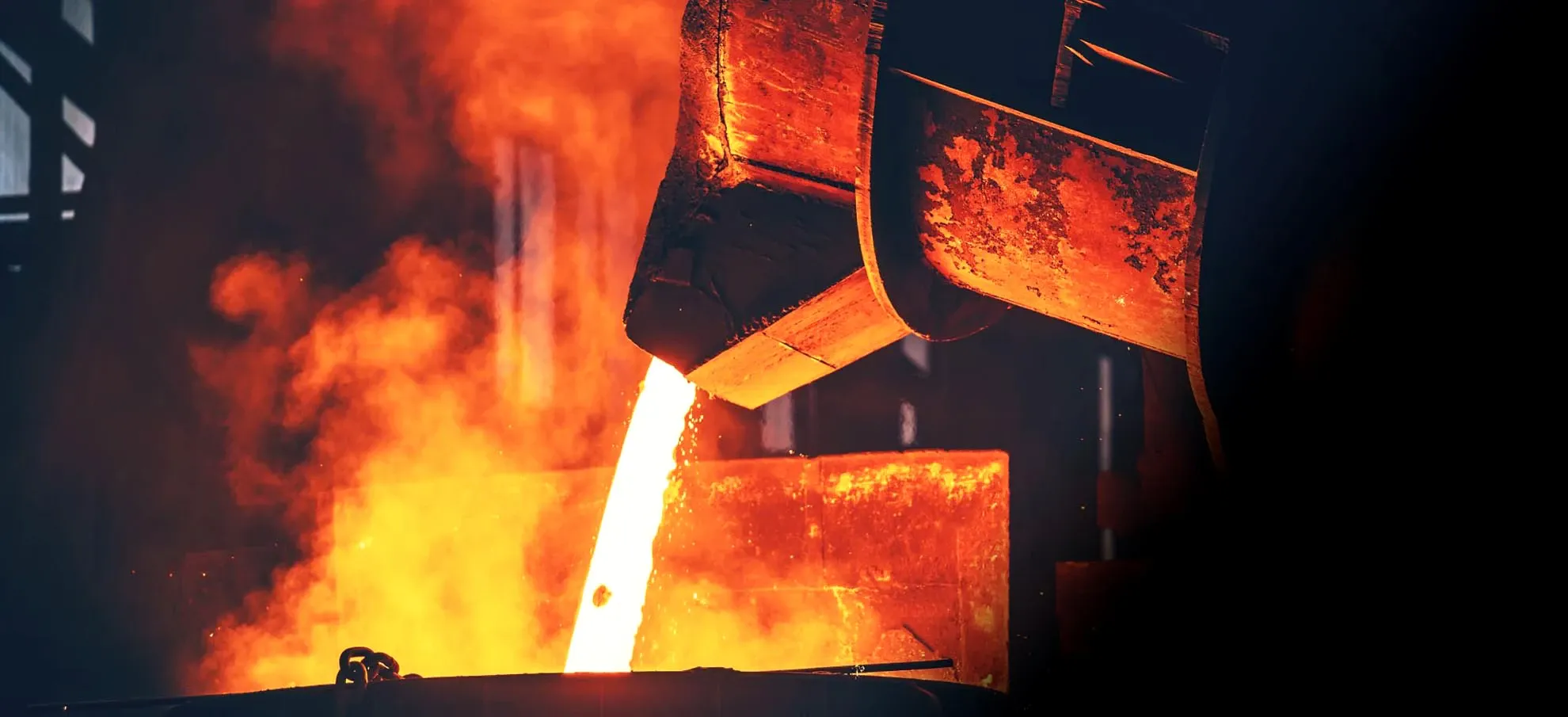The production process of manganese alloys: ferro manganese and silico manganese. Learn about their uses in steelmaking.
Dive into our world.
Ferro manganese
- FeMn is used as a deoxidizing and desulphurizing agent in carbon steel and stainless steel.
- FeMn improves the hardness and wear resistance of steels.
FeMnHC is produced by the carbothermic reduction of lumpy or sintered manganese ore in a three-phase submerged electric arc furnace (SAF). The raw material is gravity-fed into the smelting process through overhead bins. The feeding tubes are placed around the electrodes to ensure an even distribution of raw materials to the furnace. For the production of FeMnHC, the SAF differs from the furnaces that are normally used for the production of other ferroalloys. Because of the high vapour pressure of FeMn, the smelting process requires cautious temperature control because the charge should not be overheated. The vapour pressure along with a relatively low resistivity of the FeMn burden results in a low current density of the electrodes. As a result, the furnace needs to be operated at a low voltage which requires a larger diameter of the electrodes for the high current that is needed for the process.
SAFs for the production of FeMn are operated only with self-baking electrodes. Because of the large diameter, the use of pre-baked electrodes is uneconomical compared with the self-baking electrodes. Self-baking electrodes consist of a stiffened mild steel or stainless steel casing which is filled with a carbonaceous paste, consisting of a solid aggregate, usually calcined anthracite, and a binder of coal tar pitch. The tar becomes plastic when hot and fills the entire volume of the casing. On further heating of the electrode by the current and furnace heat, the paste is baked and becomes solid.
The liquid alloy and the slag can be tapped off continuously or in regular intervals. The liquid alloy is cast into moulds lined with crushed FeMn. A casting machine can also be used for casting the liquid alloy. The solidified alloy is then crushed and screened for specific needs. Slag is normally obtained as rich slag (with about 30% Mn) and is used further for the production of Si-Mn. There are some facilities where the CO-rich off-gas is used to produce electricity. The CO-rich gas can also be utilized for other industrial uses, for example as a raw material for chemical synthesis.
For the production of FeMnMC, two different routes can be used. They are
(i) the silico-thermic reduction of manganese ore, and
(ii) the decarburization of FeMnHC in an oxygen-blown converter.
The most important process is the decarburization of FeMnHC.
For the decarburization of FeMnHC, oxygen is blown into the liquid alloy, which is tapped off from the furnace into a ladle. The oxygen blown into the liquid oxidizes part of the manganese and increases the bath temperature from about 1350 deg C to 1550 deg C. With increasing temperatures, the carbon present in the FeMnHC also tends to oxidize which again raises the temperature from 1550 deg C to 1750 deg C. The oxidization of carbon consequently reduces the carbon content of the FeMn. For the production of FeMnMC, the decarburization process ends when a corresponding carbon content of about 1% to 3% is reached. The high temperature also leads to the vaporization of FeMn which leaves the process as fumes. The fumes can be collected by using hoods and further abatement by a bag filter or electrostatic precipitators (ESP).
In contrast to the refining process that uses FeMnHC as a raw material, silico-thermic production needs manganese ore and lime or a high-grade slag and SiMn. The reduction itself is performed in a three-phase SAF, with electrodes made of graphite. At the end of the cycle, the molten alloy and the slag are cast and separated. The slag is recycled after cooling and crushing as a raw material in the production of SiMn. The fumes of the furnaces are dedusted in a bag filter. With the silico-thermic reduction, the production of FeMnMC containing less than 1% carbon C is possible. The main advantages of the refining process are the lower operating temperatures and lower capital investment costs.
FeMnLC is traditionally produced by a silico-thermic process route. A rich slag is suitable as a raw material due to its low level of impurities. Also, the presence of already reduced manganese oxides in the rich slag is favourable for the process. The production of FeMnLC in a SAF is very similar to the production of FeMnMC by the silico-thermic process.
Recent process developments have made the decarburization of FeMnC an economical and environmentally favourable processing route for the production of FeMnLC. A carbon content of less than 0.5% can be achieved, but usually 0.75% is produced.
Silico manganese
- SiMn is a preferred ferroalloy during steel making.
- It has emerged as a more important alloy than FeMn.
- It is used as a substitute for FeMnLC.
- It is also required as a raw material to produce FeMnMC and FeMnLC.
- The standard grade contains manganese in the range of 62-68%, Si in the range of 12-18% and carbon in the range of around 2%.
- The low carbon grade of SiMn has a carbon level of 0.1% maximum.
The production of SiMn is based on manganese ore or sinter and quartz as raw material. Instead of manganese ore, a rich FeMn slag like that produced as rich slag in FeMnHC, FeMnMC and FeMnLC production may be used as a manganese source. The furnaces are the same or very similar to those used for FeMnHC production and often a furnace is operated with alternate campaigns of each alloy. According to the composition of the feed mix, SiMn with a silicon content from 12% to 35% can be produced. For proper furnace operation and effective silicon reduction, it is necessary to penetrate the electrodes deeper into the burden to reach the high temperature needed for the process.
Author for B-TRADE: Satyendra Kumar Sarna (ispatguru.com)



